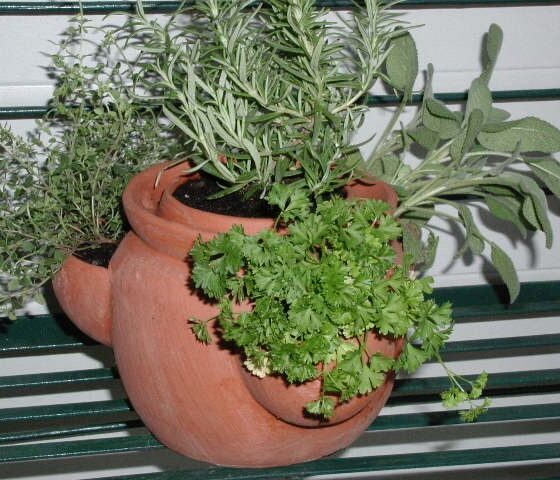A Strawberry Jar Herb Garden
Parsley, Sage, Rosemary & Thyme
A strawberry jar with pockets overflowing with kitchen herbs brings the flavors and fragrances of a miniature herb garden into your home. Place the strawberry jar near your kitchen to savor their tempting flavors and to enjoy adding just a pinch or two to your foods. In the kitchen today these herb plants are everyday herbs for Mediterranean foods from Italy and France. Use these herbs to flavor pasta sauce, herb butters, chicken, herb rice, stuffings, rubs and marinades.
The strawberry jar in the photo below contains Parsley, Sage, Rosemary & Thyme, the four famous herbs of Scarborough Fair, an old English folk song popularized by Simon & Garfunkel in their wildly successful 1966 album by the same name.
Below you will find easy steps to follow and a Photo Album Slideshow to guide you.
General Growing Tips for Strawberry Jars
Strawberry jars are just planters with side pockets. When filled with herbs, each pocket holds a separate herb plant. They come in various sizes, shapes and materials. Once used to grow strawberries, they are now popular for growing miniature herb gardens. The jar in the photo is 6” wide and the nice pockets are 3” wide. Look for jars with large pockets and chunky or squat shapes. Below is a great large strawberry jar for a patio, porch or balcony. Tall and thin jars are not recommended for growing herbs. Te rracotta clay is a traditional choice although ceramic (glazed) and plastic jars do retain the water better.
Steps to Follow
For best results follow the easy steps outlined below and displayed in the Photo Album slideshow beneath.
1. Purchase your herbs at your local nursery, herb farm, Farmer’s Market or herb festival. Select small, bushy and vigorous plants in 2-3” pots. You want a nice 3” pot of rosemary for the top. The plants shown here are larger than necessary. Look for these varieties for best results: curly parsley, common or tri-color sage, rosemary, any culinary thyme. Dwarf and compact varieties are always good choices for containers.
2. Use a premium potting soil, preferably organic. Many potting soils now include slow-release, all-purpose plant food. If not, you will need to add some to your potting soil. Feed at one-half the recommended rate and mix into your potting soil before planting.
3. If using a terracotta jar (recommended), you will need to soak the jar in a bucket of water or the sink for 20-30 minutes before planting.
Water the herb plants at the same time if needed.
4. Gather your other materials: potting soil, (plant food), garden scissors, hand dandelion weeder or dull knife, small rake or fork (bonsai tools work well), garden gloves.
5. Fill bottom of jar with potting soil. Un-pot herbs. You will plant each herb by putting the herb inside the top of the jar and pulling it through a pocket. If the parsley (or thyme) plant is too big to fit through the pocket, gently break or divide it in half with your scissors. Do not divide sage or rosemary. If there is a mass of roots at the bottom of the plant, gently pull the bottom mass off. (Don’t worry, the plant will benefit from this gentle pruning.)
6. As you pull each herb from the inside through the pocket, fill the jar with more potting soil. Try to angle the roots of the plant downward rather than sideways. The dandelion weeder can be helpful here. After planting the rosemary on top, run the weeder or a dull knife around the top edge of the pot to tamp down the soil. Leave 1/2 inch of space on top for easy watering.
7. Slowly water each pocket before watering the top. A small watering can with a long spout is very useful here. Or use a small measuring cup with a spout. You may want to set the jar on a plant coaster for protection.
8. For best results place the strawberry jar near a window with bright light, not direct sunlight, or in a protected bright spot on a porch or balcony. The jar needs 5-6 hours of bright light and needs to be watered or checked daily. Always water each pocket separately before watering the top. If you are going away for the weekend, move the jar out of the sunlight into a low-light spot.
Please enjoy your beautiful new strawberry jar filled with fragrant and flavorful herbs and do not forget to check it daily. When the potting soil feels dryish to the touch on the top or in any of the side pockets, it is time to water. Smaller strawberry jars may need to be watered daily.











The jars are cute, perfect for strawberries. And it comes in a unique design. The plants can grow conveniently because it has many openings.